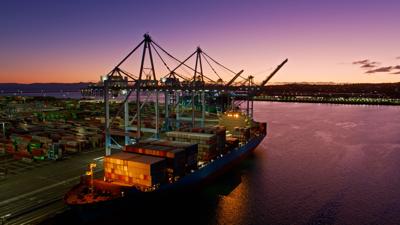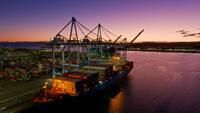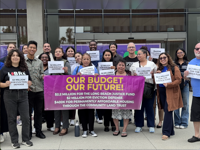
Aerial shot of a massive ship in the Port of Los Angeles at twilight. (Getty Images)
California’s port traffic is beginning to look worse now, under the effects of President Donald Trump’s fickle tariff policy, than it did at the height of the COVID-19 pandemic.
“The vessel calls, or cancellations, that we’re seeing today (are) starting to exceed the number that we saw in COVID-19,” Mario Cordero, chief executive of the Port of Long Beach, said in an interview with CalMatters in early May.
At Port of Los Angeles, Executive Director Gene Seroka said during a media briefing last week that the port expected 80 ships to arrive in May, but 17 have been canceled. By comparison, last year through May there were a total of 12 cancellations. There are 10 cancellations for June already, he added.
Farther north, the Port of Oakland saw a 15% month-over-month drop in container activity in April, spokesperson Matt Davis said. It was the first significant decline this year, as tariffs went into effect.
The challenges presented by Trump’s tariffs are “not like COVID,” said Martha Miller, executive director of the California Association of Port Authorities, at a business roundtable last week. The unpredictability of Trump’s edicts means there won’t be a surge of cargo, she said; many businesses are waiting to act, including to order goods for import.
Data for the state’s three biggest ports confirm that jobs are dwindling for longshore workers up and down the state. The numbers of gangs — teams of varied sizes that work to handle cargo — at each of the ports have declined in the past few weeks, and have dropped year over year. Besides the numbers of containers at the ports, gang numbers are another indicator of the amount of work available.
Gary Herrera is president of the International Longshore Workers Union Local 13, which represents port workers in both Long Beach and Los Angeles.
Part-time workers are not getting any hours right now, Herrera said during a media briefing with Long Beach officials. He told CalMatters that full-time workers — who get first dibs on jobs — may not be getting 40 hours a week, either. Herrera was also speaking on behalf of a couple of other locals; altogether they represent about 9,000 full-time and 6,000 part-time port workers.
As the tariff drama drags on, the impact will be felt by other workers along the supply chain, from truck drivers to the staff at warehouses to rail workers and those who work in retail. If and when people don’t have enough work or lose their jobs, their communities and local economies will suffer, port officials and workers say.
“We live and we work in our community,” Herrera said during a recent media briefing with Long Beach officials. “We spend in our community.”











(0) comments
Welcome to the discussion.
Log In
Keep it Clean. Please avoid obscene, vulgar, lewd, racist or sexually-oriented language.
PLEASE TURN OFF YOUR CAPS LOCK.
Don't Threaten. Threats of harming another person will not be tolerated.
Be Truthful. Don't knowingly lie about anyone or anything.
Be Nice. No racism, sexism or any sort of -ism that is degrading to another person.
Be Proactive. Use the 'Report' link on each comment to let us know of abusive posts.
Share with Us. We'd love to hear eyewitness accounts, the history behind an article.